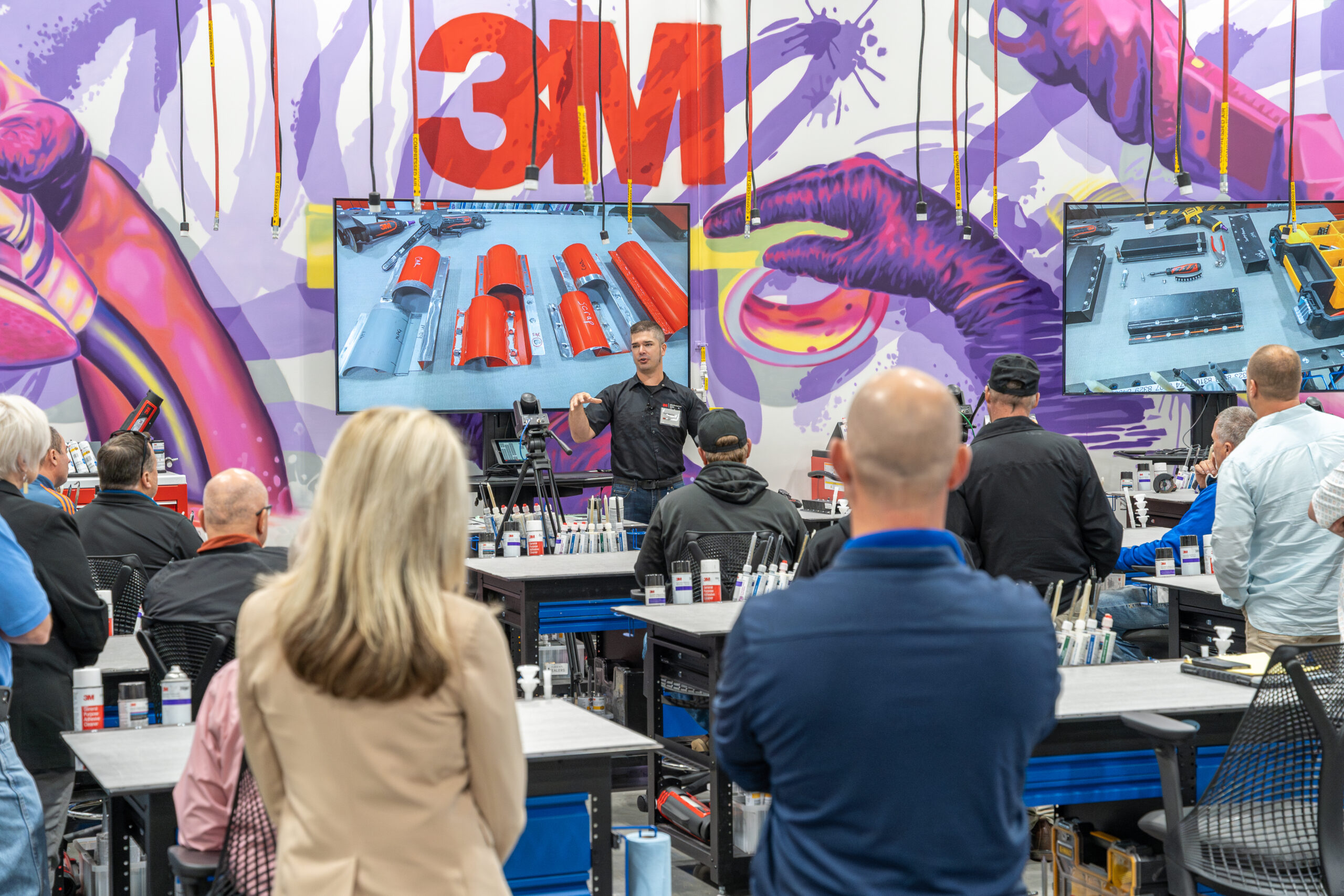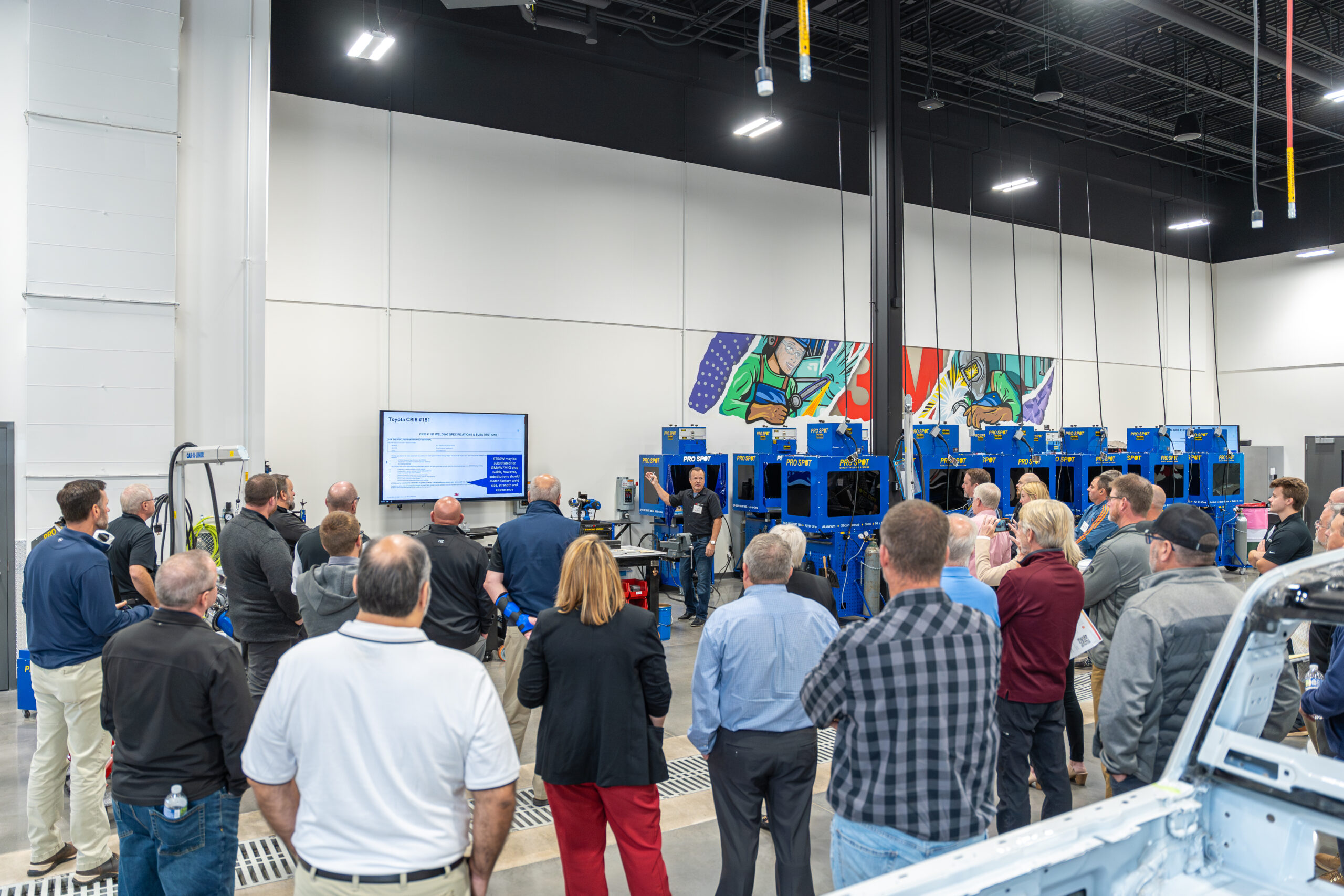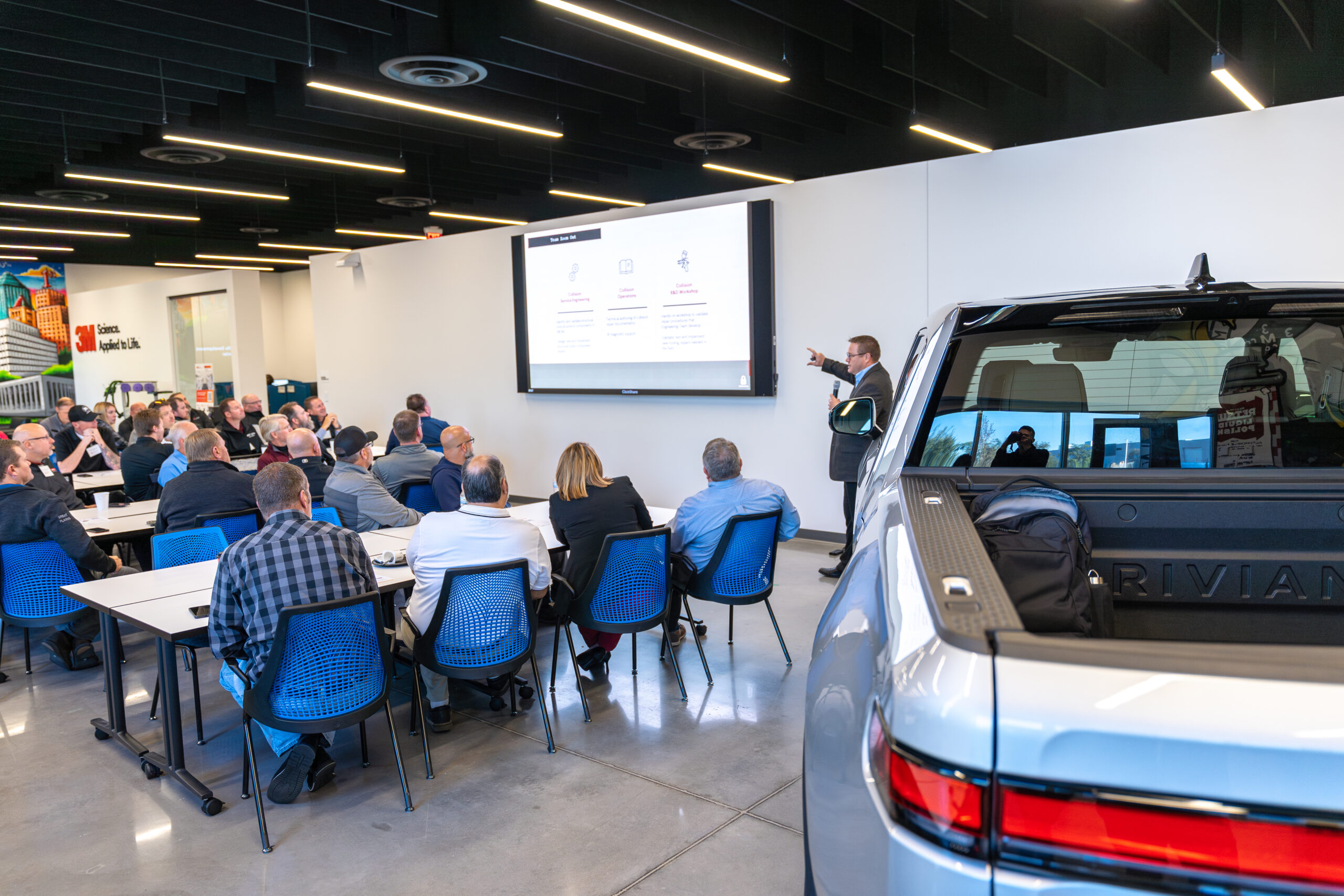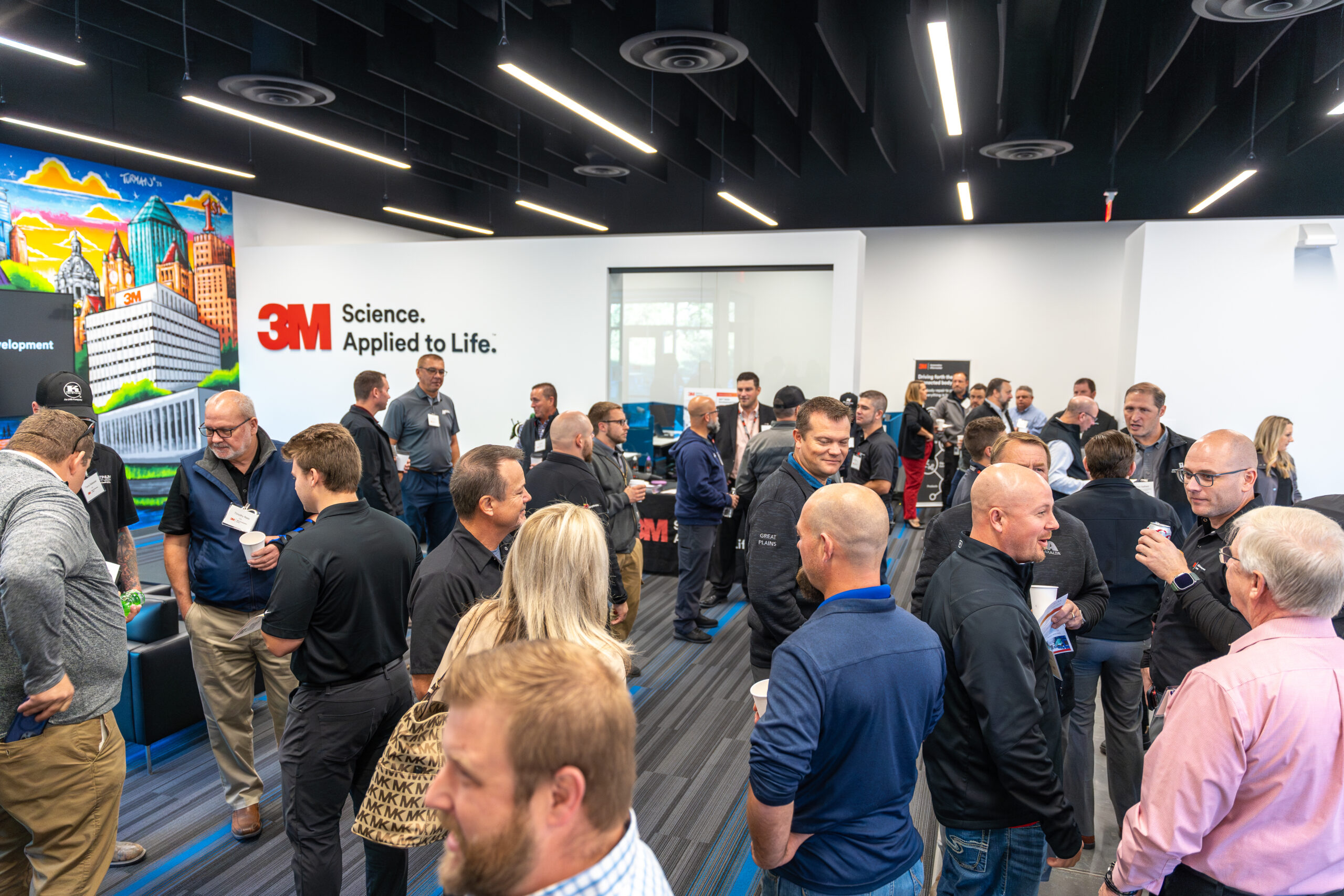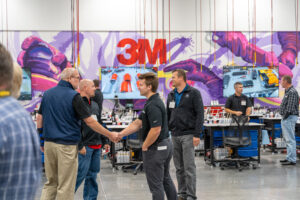
New 3M Skills Development Center looks to fill skills gaps, address tech shortage
By onCollision Repair | Education
The new 3M Skills Development Center, a new, 15,000-square-foot, state-of-the-art training facility in St. Paul, Minnesota, is now open to train students and technicians of all experience levels.
The skills center has been in the works for several years and slightly delayed by the pandemic. 3M says the goal is for it to be part of the solution to repair centers needing qualified collision repair technicians amid the ongoing tech shortage that makes it difficult to attract and retain talent. Due to the rapidly evolving industry resulting in increasingly complex repairs and pressure for higher productivity, 3M saw the need for more intensive and hands-on training opportunities.
Two courses, one on body repair and another on paint preparation and refinish, are currently running regularly at the center. The classes don’t result in any certifications but do offer I-CAR credits.
According to last year’s FenderBender Industry Survey, 34% of the 506 survey respondents said a shortage of qualified technicians is one of the numerous serious challenges facing the industry. At the time though, 72% said they expect their sales to only increase over the next five years.
The TechForce Foundation projects a shortage of more than 100,000 collision repair technicians by 2026.
While announcing the opening of the new skills center, 3M said, “A firm foundation of knowledge, rooted in rich teaching and training, is critical for shops to adapt. Shops with properly trained staff can realize increased profit margins as experienced technicians can complete jobs faster, more efficiently, and with fewer errors.”
3M Automotive Aftermarket Division President Dave Gunderson added investment in training is crucial because of rapidly changing vehicle technology and the tech shortage.
“Whether technicians are here to deepen their skills, challenge their own experiences, or learn from experts to broaden their knowledge of collision repair, we want the 3M Skills Development Center to be the source of continuing education for industry leaders,” he said.
In an interview with Repairer Driven News, 3M Automotive Aftermarket Division Senior Application Engineer Ryan Marrinan said the focus is teaching the collision repair process from start to finish by playing out scenarios of jobs they likely will encounter.
The center, he added, not only provides a location to train but, without shame and embarrassment, also guides them away from repairs they’ve been doing incorrectly.
“We work closely with many OEMs across the world… and that includes getting feedback from them on what’s most important with, particularly training, [on] their different makes and models and then emphasizing that with our technicians within the training center,” Marrinan said. “Many times, they’re doing an exercise on a sample piece of an actual repair on the vehicle but within the facility we’ll have an actual vehicle there that we can walk them through and show them here’s what we’re talking about… and really building that confidence… but really helping fill some of those gaps; the simple things that may have been missed.
“It’s a safe space to make mistakes. It’s safer to make mistakes within our facility here in St. Paul with certified, qualified instructors rather than on customers’ cars that are potentially going to be going back on the road [with] improper [repairs].”
For example, improper welding during collision repairs on a vehicle can be detrimental to the safety of the passengers in another collision by not properly absorbing and managing crash energy as the OEM designed and built it to.
“We’re putting them back on the road to withstand the same or potentially worse accident and perform exactly the way it was designed by the original manufacturer,” Marrinan said. “Welding is one of those really big hot-button issues where the change and how it’s done, why it’s done, and the different types of equipment needed to perform these welds properly is really, I would say, at the top of the list for needs within the industry.”
In addition to the basics, more complex repairs, including on electric vehicles (EVs) are also taught at the center. Some of those skills could be instrumental for techs that have been working for 20-30 years to see how much repairs are changing, Marrinan said.
3M says its skills center builds on its suite of online Collision Repair Academy training programs by offering a dedicated physical space for technicians to receive comprehensive and hands-on training courses led by seasoned collision repair experts.
Core to the 3M Skills Development Center are multi-day training courses for technicians that are focused on body repair, paint preparation, and refinishing.
Every summer, vocational-technical instructors from across the country will be invited to the center for intensive training courses on proper OEM repair procedures. Leading instruction at the 3M Skills Development Center is a staff of collision repair veterans who bring over 85 years of combined industry experience and expertise in OEM repair procedures and requirements, with 60 of those years spent working on the repair center floor as technicians.
A key design theme in the 3M Skills Development Center is its flexibility. The modular layout of the facility can be adjusted to adapt to the needs of the students and partners in attendance, for example, with movable workstations. Seventy percent of the building’s square footage houses hands-on work environments and the rest with traditional classroom space.
The center has workshop stations with 24 drops for electrical and air service. This is accompanied by a 35-foot GFS XL paint booth with 3-stage filtration, which is among one of the largest automotive paint booths available on the market, and capable of accommodating 16 painters at the same time, 3M said. There is also dedicated space for welding that includes 12 stations, each equipped with fume extraction hoods.
“Most of the technicians who are employed in our trade, they’re what we call kinesthetic learners,” said Jason Scharton, 3M global expertise delivery senior manager. “They learn by doing — putting their hands on and doing — so that’s a major component of our training.
“But one of the things we’ve learned is a growing component of importance is the social learning aspect; where the students get to discuss amongst themselves what they’re doing. They get to share their stories, their experiences, not only with each other but with the instructors and back and forth… that really help people learn from each other and reinforce the concepts that we’re really trying to get across.”
During a presentation held at the Oct. 11 grand opening of the facility, Rivian Collision Repair Programs Director Kelly Logan said the industry can never have enough training, from suppliers or OEMs.
“Education is critical,” he said. “The industry is only going to become more challenging with repair complexity continually going up. That’s why 3M developing this training facility is so key.
“Vehicles have become much safer. When we have accidents, people do walk away from them. When we think about doing vehicle repairs properly, safety always trumps everything. Having seen the evolution of vehicles over time, even basic, lower-cost vehicles are sophisticated and require complex repairs. At the end of the day, the proper repair is the only thing that matters to the customer. That’s why we need a consistent pipeline of talented technicians into our field.”
More than 100 training sessions can be held at the center annually, potentially providing hands-on education to over 1,000 technicians and associated industry professionals ranging from industry veterans looking to enhance their comprehensive understanding of the latest OEM specs and repair Standard Operating Procedures to students who are exploring careers in collision repair and attending vocational training for the first time.
“With the way the collision repair industry is changing, training is very important to me so I can keep up-to-date with new materials and processes and offer the most knowledge I can to my students,” said Bree Downs, an auto body collision repair instructor at Seward County Community College who recently attended a four-day vocational-technical instructor training at the 3M Skills Development Center. “With the knowledge I gained at the 3M training, I will be able to teach my students the most current repair methods. When they enter the workforce, they will be able to complete the repairs in the most efficient and effective way possible.”
The 3M Skills Development Center was built on land that housed the company’s first operations outside of Duluth and Two Harbors so it was imperative to add design features that showcase the company’s deep connection with the local community, 3M said. Four Minnesota-based artists — Adam Turman, Rock “CYFI” Martinez, Biafra, and Wundr — were commissioned to create murals inspired by 3M history, local culture, and the collision technicians the facility will serve.
Images
Featured image: Collision repair industry professionals got a look inside the new 3M Skills Development Center in St. Paul, Minnesota on Oct. 11, 2023 during an open house event. (Credit: 3M)
3M Automotive Aftermarket Division Senior Application Engineer Ryan Marrinan speaks during the 3M Skills Development Center open house on Oct. 11, 2023. (Credit: 3M)
Collision repair industry professionals got a look inside the new 3M Skills Development Center in St. Paul, Minnesota on Oct. 11, 2023 during an open house event. (Credit: 3M)
Rivian Collision Repair Programs Director Kelly Logan speaks during the Oct. 11, 2023 3M Skills Development Center open house. (Credit: 3M)
Collision repair industry professionals got a look inside the new 3M Skills Development Center in St. Paul, Minnesota on Oct. 11, 2023 during an open house event. (Credit: 3M)

